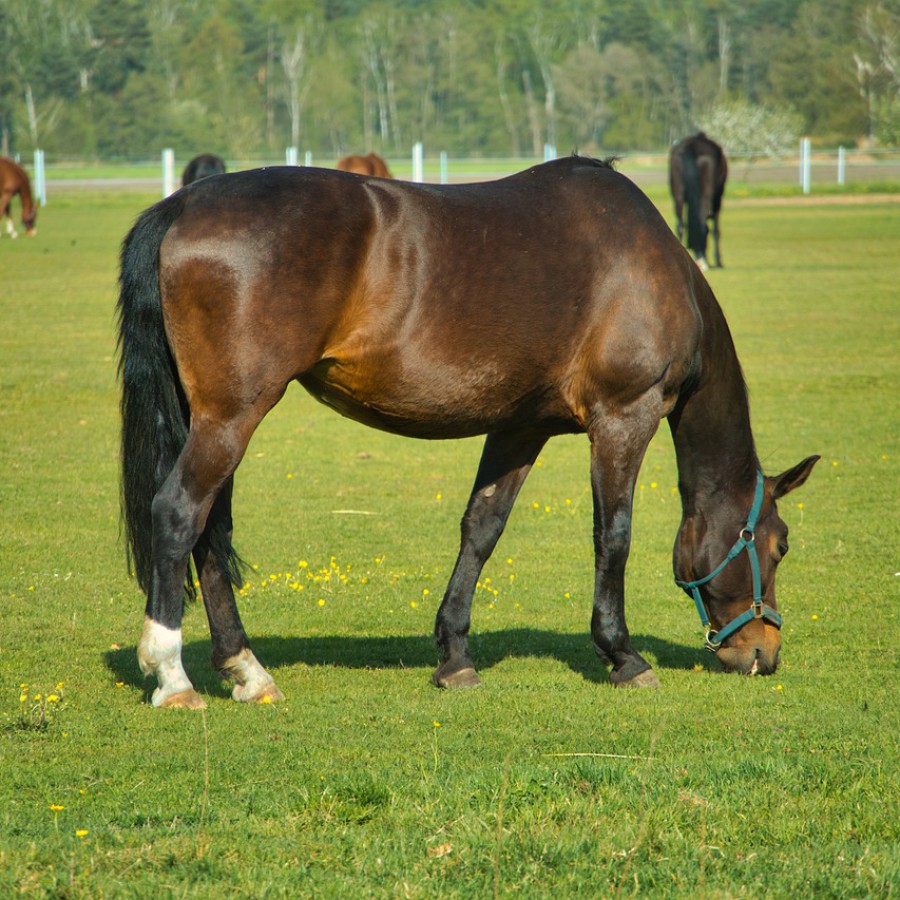GIVE LAMINITIS NO CHANCE WITH THESE 4 TIPS
 Has your horse or pony ever suffered from laminits? Of course, you would like to do everything you can to avoid this in the future. After all, it is terribly painful… and not only for your horse. As an owner or caretaker, you often find yourself helpless and with a great sense of guilt. That is why we would like to give you some tips to combat or prevent laminitis. Has your horse or pony ever suffered from laminits? Of course, you would like to do everything you can to avoid this in the future. After all, it is terribly painful… and not only for your horse. As an owner or caretaker, you often find yourself helpless and with a great sense of guilt. That is why we would like to give you some tips to combat or prevent laminitis.
Laminitis has various causes. The condition most often occurs in the spring, summer and fall and in overweight horses and ponies. Unfortunately, all types of horses can get laminitis, all year round. Proper nutrition and treatment are essential to protect your horse or pony. Keep in mind that laminitis is a serious condition, and it is best to seek veterinary advice if you think your horse or pony is suffering from it.
1. Address hay intake
- Does your horse need to lose weight? Make sure your gets analysed for its non-structural carbohydrate (NSC)content. It should contain less than 10 - 12% NSC.
- NEVER starve an overweight horse or pony, even if they are suffering with laminitis. Studies have shown that no horse should ever be fed less than 1.5% of their bodyweight in forage as this can significantly increase the risk of digestive and behavioural issues.
- Make sure you are weighing your hay. It can be easy to under or overestimate when feeding by slice, wedge, armful or haynet.
- If low NSC hay cannot be sourced, hay can be soaked to reduce the starch, sugar and calorie content.*
- Some hay can be replaced with good quality oat straw to reduce the calorie intake of the diet, as long as the horse has good dentition.
*Important tip - Soaking hay for long periods of time has been shown to increase the bacterial profile of the hay which can cause other issues, such as an increased risk of the immune and digestive issues. Hay should be soaked for no longer than 30 minutes in warm water or 60 minutes in cold water. This has been shown to reduce starch and sugar levels by up to 40% while not increasing bacterial growth to a dangerous level.
2. Consider grass intake
- If you have a horse or pony that is very laminitic-prone, you may need to remove grass from their diet completely. This does not mean your horse needs to be confined to their stable! Many yards now offer bare dirt paddocks supplemented with hay for horses that cannot have grass.
- Try and make sure that horses only graze when sugar levels in the grass are at lower levels. Overnight (late evening until early morning) is the best time.
- Grazing muzzles have been shown to decrease grass intake by up to 83% and are a great way to allow horses turnout time whilst minimizing grass intake.
Top Tip - Don’t assume that poor grazing is lower in sugar. Poor grazing is often much higher in sugar than longer, well-maintained pasture. Stressed grass (from overgrazing, lack of nutrients, lack of water etc) will not grow but will continue to make and store sugar. As this sugar is not being used for growth it will instead be eaten by your horse or pony.
3. Exercise
- Exercise is an essential part of preventing obesity and the issues associated with it, e.g. Equine Metabolic Syndrome and Laminitis.
- Research has shown that exercise can improve insulin sensitivity, further helping to reduce the risk of laminitis.
- Exercise programs must be designed with the individual in mind and a realistic assessment of the horse, made to establish a safe fitness regime.
- Most of us lead busy working lives but just 20 minutes of exercise a day can help encourage weight loss. With a little thought, you can come up with some innovative exercise ideas that save you time but help keep your horse active and sometimes also helping keep you fit too!
4. Don't forget the hard feed
- If feeding a forage only diet, your horse is likely to be lacking in certain key nutrients such as copper, zinc, manganese and vitamin E. If hay is being soaked, quality protein levels are also likely to be low.
- To ensure these nutrients are being supplied whilst still reducing the risk of laminitis, aim to feed a hard feed that is low in starch and sugar and high in fibre.
Top Tip - When looking at starch and sugar level of the hard feed also think about the feeding rate. Some balancers appear to have a higher starch level compared to a mix or cube but due to the low feeding rate actually provide less starch in grams. For example a feed with 10% starch but a feeding rate of 500g per day will supply the same quantity of starch in grams as a feed with 2.5% starch but a feeding rate of 2kg per day (both will provide 50g of starch per day).
Which Saracen feeds are recommended?
Shape-Up
Shape-Up is based on digestible fibre sources, helping to keep sugar and starch levels low. It has been specifically formulated for equines with an increased risk of laminitis due to metabolic issues and as such contains a range of ingredients to help support normal metabolism, such as magnesium, omega 3 fatty acids and cinnamon. While every effort should be made to try and prevent horses going for long periods with nothing to eat Shape Up™ may help to maintain normal pH levels in the stomach and fermentation patterns in the hindgut as it contains a Acid Buf, a marine derived natural buffering agent. It also includes a mycotoxin binder to effectively remove harmful pathogens from the digestive system. Finally, a healthy hoof package, with the research recommended 30mg/kg biotin, is included to support hoof quality and growth.
Essential Balancer
Essential Balancer is a cost-effective pelleted feed balancer designed for all horses and ponies. It can be fed alongside compound feeds being fed below the manufacturer's recommended levels, or forage only diets. Essential Balancer is low in sugar, starch and calories, so is suitable for horses and ponies that are good doers and in particular native breeds of ponies. Dense in vitamins, minerals and quality protein sources, Essential Balancer helps to maintain muscle tone and topline as well as supporting optimum health and vitality. A source of Omega 3 fatty acids helps to condition and shine the coat, creating a picture of health inside and out. The use of a live yeast has also been shown to help support feed and forage digestibility and maintaining a stable gut microflora population during times of stress, e.g. travelling, competing or sickness.
Do you have any questions? Or are you looking for specific nutritional advice for your horse? Please contact nutrition expert Lizzie Drury of Saracen Horse Feeds. This can be done by e-mail to riggnace@wlootvooet.bre, distributor for Saracen in Belgium.
|

 Has your horse or pony ever suffered from laminits? Of course, you would like to do everything you can to avoid this in the future. After all, it is terribly painful… and not only for your horse. As an owner or caretaker, you often find yourself helpless and with a great sense of guilt. That is why we would like to give you some tips to combat or prevent laminitis.
Has your horse or pony ever suffered from laminits? Of course, you would like to do everything you can to avoid this in the future. After all, it is terribly painful… and not only for your horse. As an owner or caretaker, you often find yourself helpless and with a great sense of guilt. That is why we would like to give you some tips to combat or prevent laminitis.